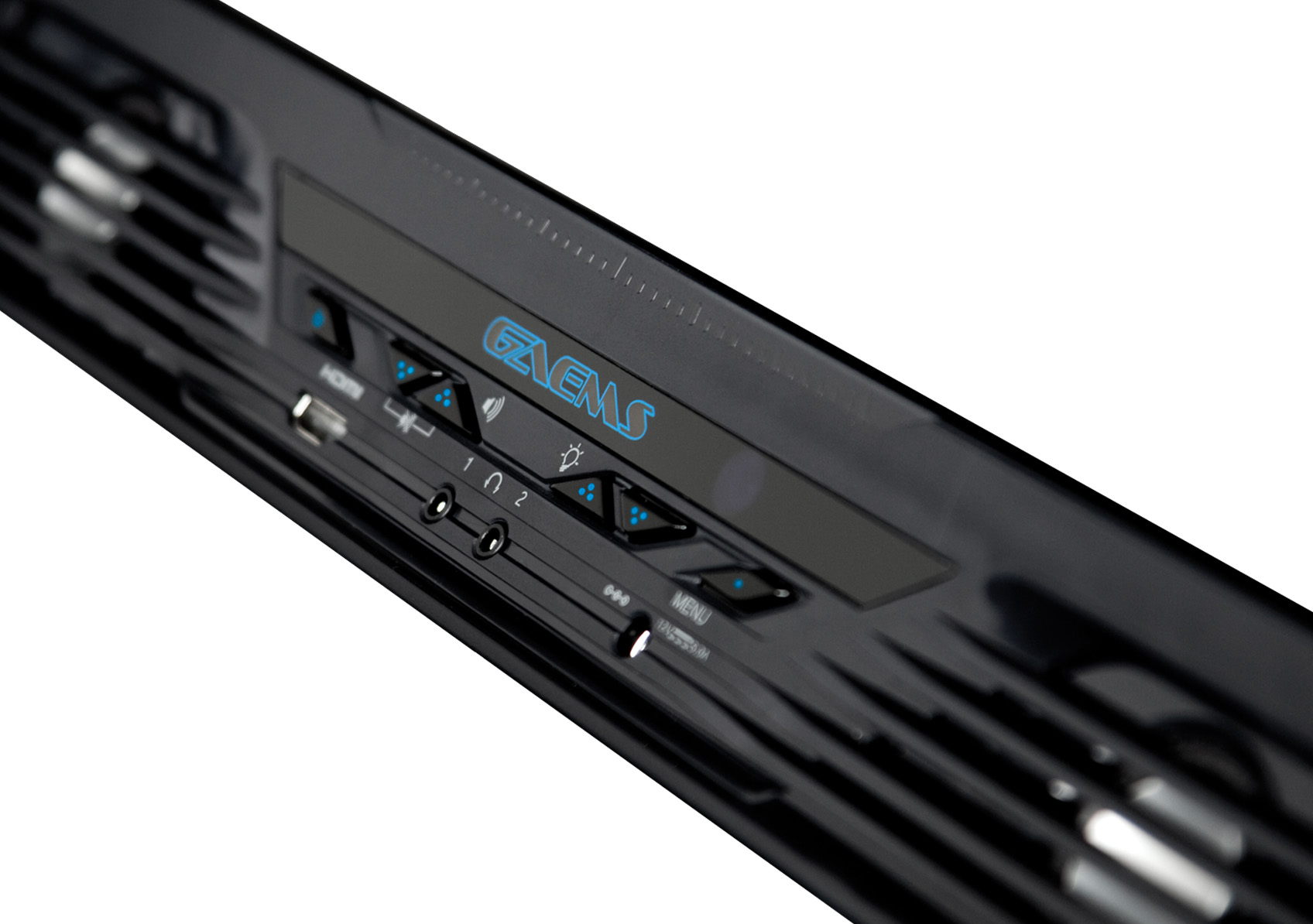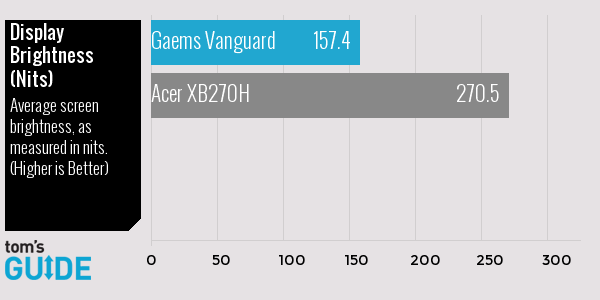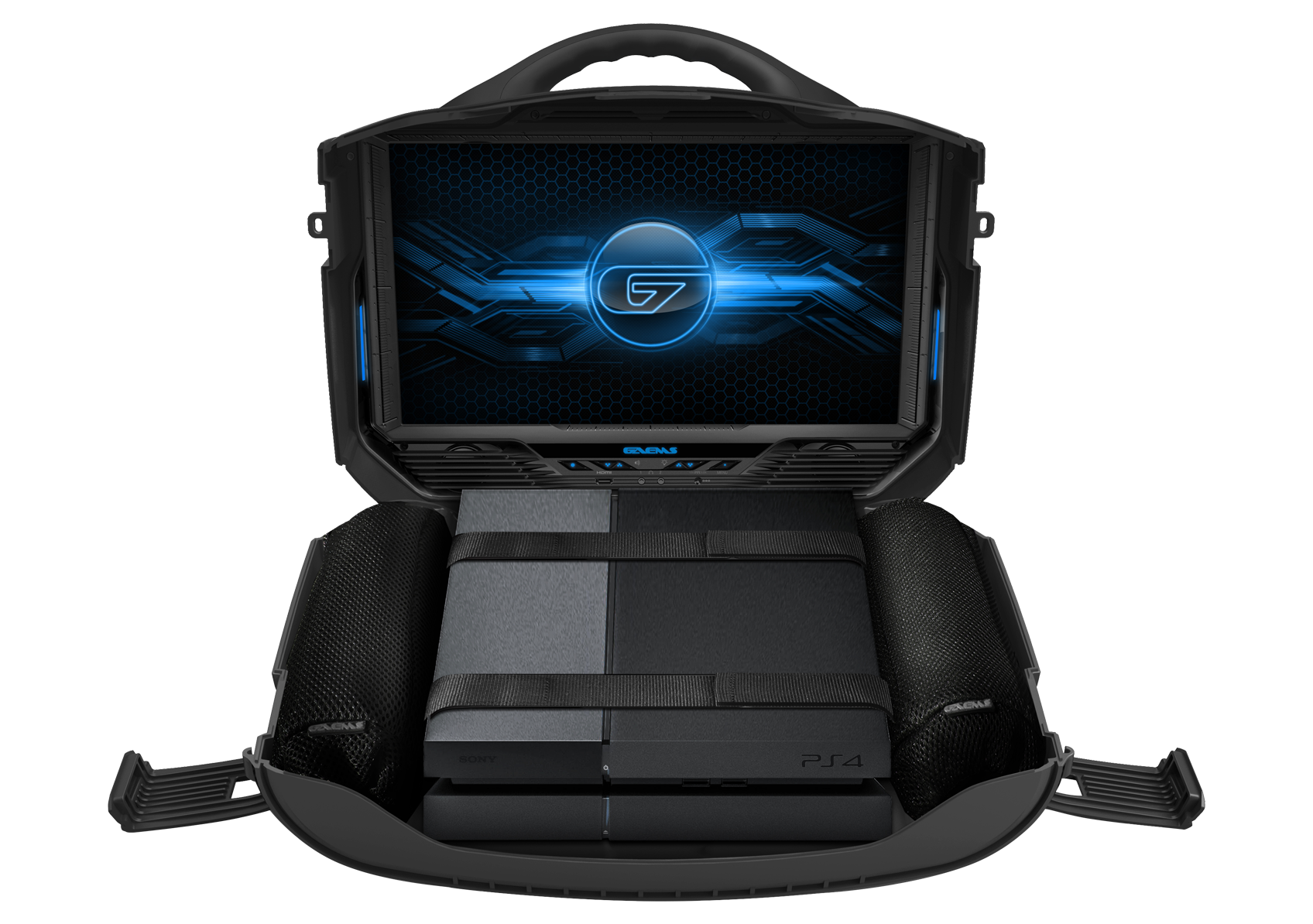Tom's Guide Verdict
The Vanguard's travel-ready design fills a unique niche in the gaming sphere, but it's pricey and not as good as a stand-alone monitor.
Pros
- +
Dependable monitor
- +
Sturdy case
- +
Travel-friendly
Cons
- -
Very expensive
- -
Subpar speakers
- -
Extremely heavy
Why you can trust Tom's Guide
A vanguard is one who stands fast against incoming attackers to defend the innocent. The Gaems Vanguard ($350) may not defend your home or your country, but it will keep your Xbox or PlayStation safe from the forces of gravity, car trunks and air travel. This carrying case comes complete with a built-in, 19-inch monitor and speakers, meaning that you can take your console experience with you to a vacation spot, relative's house or hotel. The Vanguard is quite expensive and not nearly as proficient as a comparably priced monitor, but it does fill a unique niche in the gaming sphere.
Design
One glance at the Vanguard, and you can tell that it means business. The case is hard, black plastic, which seems difficult to damage, short of applying massive blunt force. The overall package resembles an oversized briefcase, with only a Gaems (yes, the spelling of the word hurts my soul) logo on the front to give some spice to the design. A handle on top provides solid purchase to carry the case in one hand, although most users will probably want to attach the sturdy shoulder strap and adjust it for a more comfortable fit.
This solidity comes at a price: When used as intended, the Vanguard is incredibly heavy. With an Xbox One inside, the overall package weighed 18.4 pounds. (Gaems recommends that users pack cables separately, although photos on the company's website show cables inside the case.) By contrast, a carry-on bag full of clothing usually weighs between 8 and 11 pounds. If you have to carry the Vanguard through an airport, you may come to wish that you hadn't.
MORE: Best Xbox One Games
Opening up the case, I noticed the inside looks a lot like the outside: Spartan, but effective. On the bottom, users place a foam pad, load the console on top and strap that down with Velcro. This may not seem like the ideal way to secure a console, but I walked all around the office with an Xbox One inside the case, and the system didn't budge. The case also worked well for a PS4 and an Xbox 360, although I wouldn't recommend it with an old-school PS3 due to that system's curved design. (A PS3 Slim would probably be fine.)
The pièce de résistance is the 19-inch, 1080i monitor lodged in the top of the device. By opening the Vanguard and laying it flat, you get a miniature gaming station that you can take with you anywhere, complete with a mini-HDMI cord. The large case surrounding the display prevents glare, and the monitor is elevated enough so that a console does not cut off any of the screen.
While the Vanguard is bulky and heavy, the fact that it is a fully portable gaming setup is worth a respectful nod. You might rue the day you decided to schlep the Vanguard to the ancestral family home for Thanksgiving, but the device should serve you well once you get there.
Get instant access to breaking news, the hottest reviews, great deals and helpful tips.
Ports and Interface
Since it is not a full-fledged gaming monitor, the Vanguard is admirably lightweight when it comes to ports. There's a power port (which powers only the screen, so you'll have to plug the console in separately) and an HDMI port. That's it. As such, while it's optimized for game consoles, the Vanguard could also act as a display for a Chromecast or even a gaming PC in a pinch.

The menu interface is likewise straightforward, and even a little bit deeper than I expected. By accessing the menu from either the monitor or the remote control, you can alter options like brightness, contrast and saturation for the screen, and treble, bass and equalization for the speakers. The lack of a dedicated Back button on the remote makes navigating a little tedious sometimes, but the Vanguard lets you adjust plenty of settings in a relatively easy way.
Performance
While you could plug almost anything with an HDMI port into the Vanguard, Gaems produced the device with consoles in mind. As such, I spent the majority of my time testing how an Xbox One looked and played on the Vanguard. The results were promising, but not perfect.
First, buyers should be aware that the monitor defaults to 720p (which is common for 1080i displays). This is hardly a deal breaker, since full-1080p resolution is arguably not necessary on a 19-inch screen. Still, 19-inch 1080p monitors do exist (often for less than $350, to boot), and in the interest of graphical fidelity, using one would have been a welcome addition.

As for how games look, they're OK. I played through a good chunk of Assassin's Creed IV: Black Flag, a game with which I spent dozens of hours when it first came out. Everything looked decent, from the rough texture of Edward Kenway's clothes to the Bahaman waters lapping up against sandy beaches and green palm trees. The graphics were not as crisp and sharp as I've come to expect from current-gen systems, but the color seemed more-or-less on-point. Dragon Age: Inquisition on PS4 looked similarly good, albeit a bit darker than I'm used to.
I also watched some TV shows to determine how the Vanguard handled for more passive entertainment. An episode of Parks and Recreation was a little too saturated under the default settings, but I managed to get it down to an acceptable level of saturation after playing with the menu options. I fared much better with BoJack Horseman, a Netflix-original animated sitcom. The Vanguard's high natural saturation helped to highlight the show's rich purples, blues and greens.
Brightness, Color and Latency
Based on our measurements, the Vanguard is not the brightest monitor on the market, but it makes up for its shortcomings with excellent contrast and color temperatures. The Vanguard registered 157.4 nits of brightness (170 or higher is better), a color gamut percentage of 103.26 (100 or higher is excellent) and a Delta E color accuracy score of 5.58 (closer to zero is better).

Compare that to the Acer XB270H, a dedicated PC gaming monitor, which scored 270.5, 95.68 and 3.89 in the same categories, respectively.
The screen on the Vanguard has a latency of 10.6 ms, which is about standard for gaming monitors.
So-So Audio
My biggest complaint actually has nothing to do with the picture, but rather the sound. Monitors with built-in sound aren't terribly common, but the Vanguard claims to be an all-purpose gaming peripheral, which means that speakers are a necessity. The Vanguard has two speakers, as well as two headphone jacks. Neither solution is ideal.
While the so-so speakers worked well enough for the TV shows, they seemed to track sound poorly in Black Flag. The sound would often cut out for a few microseconds, coming back in static-filled bursts, and lose sync with what was happening on screen. These issues ironed themselves out within seconds, but it happened with too much regularity to be an isolated incident. Oddly, I did not encounter these issues on the PS4 while using the same HDMI cable, nor did they persist when I used headphones.
The headphone jacks are also a nice touch, but probably unnecessary, since both the Xbox One and PS4 allow players to attach headphones via the controllers. And for headphones with short cords, sticking your face directly into the monitor is not an ideal way to play a game.
Modes and Features
The Vanguard is rather light on picture modes. In addition to tweaking saturation, brightness and contrast by hand, you can also change the color temperature to Warm, Warmer, Cool and Cooler settings. Separate settings for movies, games, sports and so forth would have arguably been more useful.
MORE: Best PS4 Games
Beyond that, the aforementioned speaker equalization is a subtle touch for an otherwise middle-of-the-road gaming monitor. The Vanguard doesn't offer much else in the way of unusual functions, possibly because being able to pack it up as a suitcase is unusual enough on its own.
Bottom Line
Atrocious spelling aside, the Gaems Vanguard is a practical peripheral with few frills, but solid core functionality. Whether it justifies spending $350 is entirely dependent on what you need the device for. For a home setup, you'd be much better with a TV or computer monitor, and if you're traveling to a place with modern TVs, you can get a hard console case for hundreds of dollars less.
If a hard case with a built-in monitor sounds like it would complement your (presumably) travel-heavy lifestyle, though, the Vanguard works well and offers more than enough protection for your costly devices. There aren't many choices when it comes to cases with screens, so if you can live with 720p resolution and fuzzy speakers, the Vanguard is a perfectly good option.
Marshall Honorof is a senior writer for Tom's Guide. Contact him at mhonorof@tomsguide.com. Follow him @marshallhonorof. Follow Tom's Guide at@tomsguide, onFacebook and onGoogle+.

Marshall Honorof was a senior editor for Tom's Guide, overseeing the site's coverage of gaming hardware and software. He comes from a science writing background, having studied paleomammalogy, biological anthropology, and the history of science and technology. After hours, you can find him practicing taekwondo or doing deep dives on classic sci-fi.

